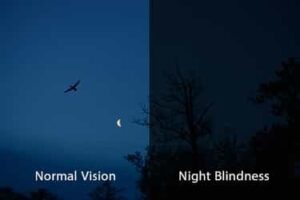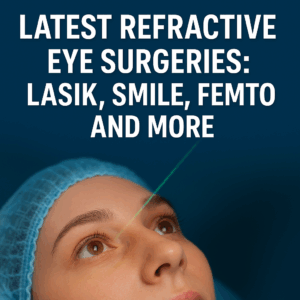
Anushka Super Speciality Eye Hospital
Call: 90044 44422 / 99213 44422 | Timings : 8.30 a.m to 5.30 p.m (Mon-Sat) | Add: Shri Swami Samarth Soc, Kaneri Dhamankar Naka, Bhiwandi




Accredited for Quality Care
Amblyopia (Lazy Eye): Types, Causes, Symptoms, and Management
anushka
10 September 2025
Amblyopia, more commonly known as lazy eye, is one of the leading causes of preventable childhood vision loss worldwide. This neurodevelopmental disorder occurs when one eye fails to achieve normal visual acuity, even with glasses or contact lenses, due to abnormal visual development in early childhood.
If amblyopia is not diagnosed and managed early, it can result in lifelong visual impairment. The good news is that with early detection and appropriate management, most children can recover good vision. In this detailed guide, we’ll explore the definition, types, symptoms, causes, diagnosis, treatment options, and prognosis of amblyopia, with insights for both parents and eye-care professionals.
What is Amblyopia?
Amblyopia is defined as reduced vision in one (or rarely both) eyes without any structural problem in the eye itself. The root issue lies in the way the brain processes visual signals—it begins to favor one eye while suppressing input from the other.
This suppression is the brain’s defense mechanism to avoid confusion or double vision, but over time it causes the “weaker” eye to lose visual development. The condition typically starts in infancy or early childhood, when the visual system is still maturing.
Why Does Amblyopia Occur?
During the early years of life, the brain requires equal, clear, and focused images from both eyes to develop normal binocular vision. If one eye provides a blurred or obstructed image for a prolonged period, the brain ignores it, and vision in that eye becomes underdeveloped.
The critical period of visual development is usually until age 7–9 years. After this window, treatment becomes much less effective, which is why early detection is crucial.
Types of Amblyopia
There are three main types of amblyopia, each with different causes and implications.
1. Strabismic Amblyopia
- Caused by eye misalignment (strabismus).
- The brain suppresses signals from the misaligned eye to avoid double vision.
- Signs: Eye turning in or out, poor depth perception, or child favoring one eye.
- Most common type of amblyopia.
2. Refractive (Anisometropic) Amblyopia
- Caused by a significant difference in refractive power between the two eyes (anisometropia).
- One eye may be more nearsighted, farsighted, or astigmatic than the other.
- Often no visible eye turn, making it harder to detect without screening.
- Common in children with uncorrected high refractive errors.
3. Deprivation Amblyopia
- Caused by physical obstruction to vision (e.g., congenital cataract, severe ptosis, corneal opacity).
- The most severe form and progresses rapidly if untreated.
- Requires urgent intervention to prevent irreversible vision loss.
Symptoms of Amblyopia
Amblyopia can be tricky to detect because children may not complain of poor vision. Signs include:
- Blurry or reduced vision in one eye
- Squinting, tilting the head, or closing one eye
- Poor depth perception and clumsiness
- Eye misalignment (crossed or wandering eye)
- Difficulty reading or focusing
Parents often notice that the child favors one eye, especially when covering the stronger eye.
Diagnosis of Amblyopia
Early detection through pediatric vision screening is key. Eye doctors use several tests to diagnose amblyopia:
- Visual acuity testing (checking difference of two or more lines between eyes)
- Refraction test (measuring refractive errors)
- Cover/uncover test (to detect eye misalignment)
- Ocular health exam (to rule out cataracts or other obstructions)
For very young children, doctors may use age-appropriate methods such as fixation preference or observing eye movements.
Causes and Risk Factors
The main causes of amblyopia are:
- Strabismus (misaligned eyes)
- Anisometropia (different refractive errors in each eye)
- Deprivation (due to cataract, droopy eyelid, etc.)
Risk factors include:
- Family history of amblyopia or strabismus
- Premature birth or low birth weight
- Developmental delays
- Uncorrected high refractive errors
Management of Amblyopia
The goal of treatment is to stimulate the weaker eye and restore balanced vision. Treatment strategies include:
1. Correcting the Underlying Cause
- Removal of cataracts or correction of ptosis if vision is blocked.
- Early intervention prevents permanent vision loss in deprivation amblyopia.
2. Refractive Correction
- Spectacles or contact lenses are the first step, especially in refractive amblyopia.
- Some children show improvement in vision just by wearing proper glasses.
3. Occlusion (Patching) Therapy
- Considered the gold standard for amblyopia management.
- The stronger eye is patched for several hours daily, forcing the weaker eye to work.
- Needs strict compliance and regular monitoring to avoid reverse amblyopia.
4. Atropine Penalization
- Atropine drops blur near vision in the stronger eye, encouraging use of the weaker eye.
- An alternative for children who resist patching.
- Less visible but may cause light sensitivity.
5. Vision Therapy & Digital Treatments
- Eye exercises and structured vision therapy programs enhance binocular vision.
- Virtual reality (VR) and computer-based games are promising newer options that engage children while treating amblyopia.
6. Surgery
- Strabismus surgery may be recommended if misalignment persists after amblyopia treatment.
- Surgery alone does not cure amblyopia but helps restore binocular function.
Prognosis and Long-Term Outcomes
- Best outcomes occur when amblyopia is treated before age 7.
- With early intervention, most children can achieve normal or near-normal vision.
- Some improvement is possible in teenagers and adults using newer therapies, though results are limited.
Risk of Recurrence
- Amblyopia can return if treatment stops suddenly.
- Gradual tapering of patching or drops and regular follow-up are necessary.
Prevention and Public Health Importance
- Routine preschool vision screening is the most effective preventive step.
- Parents should seek prompt eye evaluation if they notice squinting, head tilting, or vision issues.
- Families with a history of lazy eye or strabismus should be extra vigilant.
Frequently Asked Questions (FAQs)
1.Can adults be treated for amblyopia?
Yes, some visual improvement is possible with newer therapies, but full recovery is unlikely beyond the critical developmental period.
2.Is amblyopia genetic?
Genetics play a role, especially if there’s a family history of strabismus or refractive errors.
3.Can amblyopia cause permanent blindness?
Yes, untreated amblyopia leads to lifelong visual disability in the affected eye.
4.How long does treatment take?
Treatment duration varies from months to years, depending on severity, compliance, and age of intervention.
Conclusion
Amblyopia, or lazy eye, is a preventable and treatable cause of childhood blindness. The key lies in early detection, accurate diagnosis, and timely treatment. Management strategies—from glasses and patching to modern vision therapy and digital tools—offer excellent outcomes when started early.
For parents, being proactive about routine eye exams and seeking care at the first sign of vision problems can make all the difference. For clinicians, staying updated with evolving management approaches ensures that no child loses vision to a condition that is largely preventable.
By spreading awareness about amblyopia and encouraging early childhood eye screening, we can protect countless children from avoidable vision loss and give them the gift of clear, binocular vision for life.
Recent Posts


